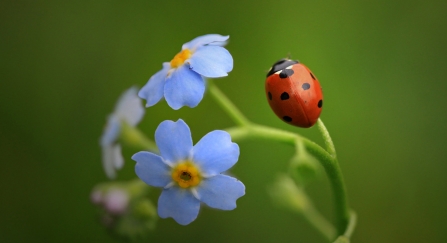
Blackbird by David Tipling/2020VISION
Blackbird by David Tipling/2020VISION

Blackbird by David Tipling/2020VISION
Set your alarm extra early once a year to listen to nature’s symphony, the dawn chorus. The dawn chorus doesn’t just happen out in the countryside, our garden birds start to sing too as they're looking for a mate and claiming their territories.
Reserves ecology officer, Colin Williams thinks the dawn chorus is “vibrant and uplifting; it’s powerful and melodic; it’s soothing, yet it’s stimulating”.
Don’t worry about trying to work out which bird is which, just absorb the lovely natural music and start your day off with this beautiful sound.

Blackcap by David Tipling/2020VISION
Joining regular garden visitors, you might hear the lovely melody of a blackcap. These are greyish birds about the size of a robin. The males have a black cap and the females a brown one.
Have a listen to their song:
In spring you never know which other birds might visit your garden. Here are some of the most common birds you might see, but as spring migrants are returning from winters in warmer countries keep an eye out for more unusual visitors, and don’t forget to look up and see what’s flying overhead.

Peacock butterfly by Les Binns
Sunny days are bringing out butterflies. Some butterflies have spent the winter as adults and are now flying around looking for a mate. You might see brimstones, peacocks, commas, small tortoiseshell, orange-tip and red admirals flying in your garden.
Did you know that the caterpillars of some butterflies feed on nettles, so keep a patch of wild garden including some nettles to help these butterflies.
Beefly by Mick Jones
Our largest and most common bee-fly, the dark-edged bee-fly looks just like a bumblebee, and buzzes like one too! It feeds on flowers like primroses and violets in gardens, parks and woodlands.

Buff tailed bumblebee by Jon Hawkins Surrey Hills Photography
The queen bees are now emerging from their winter hibernations and looking for somewhere to make their nest. Look out for them as they feed on nectar and search for somewhere to good nest site. You could help them by making a simple nest for your garden.

Common pipistrelle by Tom Marshall
On the warmer spring evenings bats will be out flying around over gardens and parks looking for insects to eat. One of most common bats you'll see is the common pipistrelle. Even though these are tiny they can eat around 3,000 insects every night!

Tadpole by Richard Burkmar
Have you got a garden pond? Did you have frogspawn and toadspawn – look out for the tadpoles and toadpoles swimming around, slowly developing into adult frogs and toads.
If you don’t have a pond, but would like to make one, here’s our how to guide for creating a pond. It’s one of the best additions to a garden for wildlife.

Hedgehog on mossy log by Coatesy for Shutterstock
Hedgehogs will be waking from their winter hibernation and looking for food to eat in gardens. To help them move around your neighbourhood you could make a hedgehog hole in your fence – don't forget to speak to your neighbour first! Why not see if you can get the whole street do the same so your gardens can all be linked for hedgehogs, helping them to roam around and find food.

Seven spot ladybird by Jon Hawkins - Surrey Hills Photography
Ladybirds are a gardeners friend, feasting on aphids. The seven-spot ladybird is the most familiar, with red wing cases and seven black spots. Did you know there are actually more than 40 species of ladybird in the UK! Here are some to look out for.
Download our free booklet to help ladybirds and other beetles

Large red damselflies by Andy Fairbairn
These are the earliest damselflies to emerge in the UK, appearing in March or April and flying until late summer, and one of our most common species.
If you've got a pond in your garden, you may see them flying around looking for a pond to breed in. Even if you have a tiny outdoor space you can still have a pond.
Follow us on Twitter, Facebook and Instagram where we share lots of beautiful photos of local wildlife, ideas to enjoy nature and ways to help wildlife at this time.
Share your stories, sightings and ideas with us too.
You can join our friendly Facebook group to share photos of wildlife that you’ve seen in your garden, get help identifying any you’re not sure about, and share ideas for getting your daily dose of nature.
Get our newsletter, including: